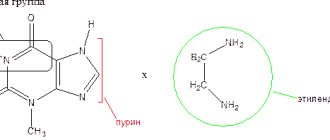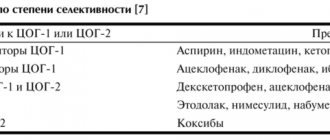pharmachologic effect
Bronchodilator, phosphodiesterase inhibitor (PDE).
It is the ethylenediamine salt of theophylline (which facilitates solubility and increases absorption). It has a bronchodilator effect, apparently due to a direct relaxing effect on the smooth muscles of the respiratory tract and blood vessels of the lungs. It is believed that this effect is caused by selective inhibition of the activity of specific PDEs, which leads to an increase in the intracellular concentration of cAMP. The results of in vitro experimental studies show that the main role appears to be played by type III and IV isoenzymes. Suppression of the activity of these isoenzymes may also cause some side effects of aminophylline (theophylline), including. vomiting, arterial hypotension and tachycardia. Blocks adenosine (purine) receptors, which may be one of the factors affecting the bronchi. Reduces airway hyperresponsiveness associated with the late phase response caused by inhaled allergens through an unknown mechanism that is not due to PDE inhibition or blockade of adenosine. There are reports that aminophylline increases the number and activity of T-suppressor cells in peripheral blood.
Increases mucociliary clearance, stimulates contraction of the diaphragm, improves the function of the respiratory and intercostal muscles, stimulates the respiratory center, increases its sensitivity to carbon dioxide and improves alveolar ventilation, which ultimately leads to a decrease in the severity and frequency of apnea episodes. By normalizing respiratory function, it helps saturate the blood with oxygen and reduce the concentration of carbon dioxide. Strengthens ventilation of the lungs in conditions of hypokalemia.
It has a stimulating effect on the activity of the heart, increases strength and heart rate, increases coronary blood flow and increases the myocardial oxygen demand. Reduces the tone of blood vessels (mainly those of the brain, skin and kidneys). It has a peripheral venodilating effect, reduces pulmonary vascular resistance, and lowers pressure in the pulmonary circulation. Increases renal blood flow and has a moderate diuretic effect. Expands extrahepatic bile ducts. Stabilizes mast cell membranes, inhibits the release of mediators of allergic reactions. Inhibits platelet aggregation (suppresses platelet activating factor and PgE2α), increases the resistance of red blood cells to deformation (improves the rheological properties of blood), reduces thrombus formation and normalizes microcirculation. It has a tocolytic effect, increases the acidity of gastric juice. In high doses it has an epileptogenic effect.
Reviews about the drug
Reviews of Euphylline, like any other medicinal drug, are very diverse on the Internet. However, most patients note its high effectiveness and rapid elimination of symptoms of the disease.
There are also negative reviews, but they are most often associated with the development of adverse reactions due to individual intolerance to a component of the drug or as a result of an incorrectly selected dosage.
Some patients use Eufillin in combination with Dimexide and a number of essential oils for weight loss and getting rid of cellulite. The effectiveness of the drug in this regard has not been proven, so it is impossible to objectively judge its effectiveness.
Attention! Before taking the medicine, consultation with a specialist is required. Only a doctor will be able to select the correct dosage of the drug, calculate the duration of the course of treatment and take into account all the indications and contraindications for taking Eufillin. Otherwise, there is a high risk of developing negative side effects.
Pharmacokinetics
In the body, aminophylline is metabolized at physiological pH values to release free theophylline. Bronchodilating properties appear at plasma theophylline concentrations of 10-20 mcg/ml. Concentrations above 20 mg/ml are toxic. The stimulating effect on the respiratory center is realized at a lower concentration - 5-10 mcg/ml.
Theophylline binding to plasma proteins is approximately 40%; in newborns, as well as in adults with diseases, binding decreases. Plasma protein binding in adults is about 60%, in newborns - 36%, in patients with liver cirrhosis - 36%. Penetrates the placental barrier (the concentration in the fetal blood serum is slightly higher than in the maternal serum). Excreted in breast milk.
Theophylline is metabolized in the liver with the participation of several cytochrome P450 isoenzymes, the most important of which is CYP1A2. During metabolism, 1,3-dimethyluric acid, 1-methyluric acid and 3-methylxanthine are formed. These metabolites are excreted in the urine. 10% is excreted unchanged in adults. In newborns, a significant part is excreted in the form of caffeine (due to the immaturity of the pathways for its further metabolism), unchanged - 50%.
Significant individual differences in the rate of hepatic metabolism of theophylline are the cause of pronounced variability in clearance values, plasma concentrations, and half-life. Hepatic metabolism is influenced by factors such as age, addiction to tobacco smoking, diet, diseases, and concurrent drug therapy.
T1/2 of theophylline in non-smoking patients with bronchial asthma practically without pathological changes in other organs and systems is 6-12 hours, in smokers - 4-5 hours, in children - 1-5 hours, in newborns and premature babies - 10- 45 hours
T1/2 of theophylline increases in the elderly and in patients with heart failure or liver disease.
Clearance decreases with heart failure, liver dysfunction, chronic alcoholism, pulmonary edema, chronic obstructive pulmonary disease.
Ethylenediamine does not affect the pharmacokinetics of theophylline.
Pharmacological effects
The main effect of the drug is antispasmodic. However, it also has other effects on the human body, namely tocolytic, diuretic and bronchodilator.
According to the Vidal classifier, Eufillin is included in the pharmacological group of phosphodiesterase inhibitors.
What does Eufillin help with? Indications for use
Indications for use of the drug Eufillin may vary slightly depending on the form of release. Tablets are most often prescribed for:
- Bronchial asthma of varying severity.
- Chronic obstructive pulmonary disease.
- Paroxysmal attacks of apnea at night.
- Right ventricular heart failure.
- Emphysema.
The injection form of the drug is used for:
- Cerebrovascular insufficiency of the brain (the drug is used in combination with other drugs and helps reduce intracranial pressure).
- Pulmonary hypertension.
- Left ventricular heart failure (also used in combination with a number of other drugs).
- For diseases of the respiratory system accompanied by spasm and broncho-obstructive syndrome (COPD, emphysema, bronchial asthma).
Indications
For parenteral use: status asthmaticus (additional therapy), neonatal apnea, ischemic cerebrovascular accident (as part of combination therapy), left ventricular failure with bronchospasm and Cheyne-Stokes type breathing disorder, edematous syndrome of renal origin (as part of complex therapy) ; acute and chronic heart failure (as part of combination therapy).
For oral administration: broncho-obstructive syndrome of various origins (including bronchial asthma, COPD, including emphysema, chronic obstructive bronchitis), hypertension in the pulmonary circulation, cor pulmonale, sleep apnea; acute and chronic heart failure (as part of combination therapy).
Side effect
From the side of the central nervous system:
dizziness, sleep disturbances, anxiety, tremors, convulsions.
From the cardiovascular system:
palpitations, heart rhythm disturbances; with rapid intravenous administration - the appearance of pain in the heart, decreased blood pressure, tachycardia (including in the fetus when taken in the third trimester of pregnancy), arrhythmias, decreased blood pressure, cardialgia, increased frequency of angina attacks.
From the digestive system:
nausea, vomiting, gastroesophageal reflux, heartburn, exacerbation of peptic ulcer, diarrhea; with prolonged ingestion - anorexia.
From the urinary system:
albuminuria, hematuria.
Allergic reactions:
skin rash, itching, fever.
From the side of metabolism:
rarely - hypoglycemia.
Local reactions:
compaction, hyperemia, pain at the injection site; when used rectally, irritation of the rectal mucosa, proctitis.
Other:
chest pain, tachypnea, flushing, albuminuria, hematuria, hypoglycemia, increased diuresis, increased sweating.
Use during pregnancy and breastfeeding
Theophylline penetrates the placental barrier. The use of aminophylline during pregnancy may result in potentially dangerous concentrations of theophylline and caffeine in the blood plasma of the newborn. Newborns whose mothers received aminophylline during pregnancy (especially in the third trimester) require medical supervision to monitor possible symptoms of theophylline intoxication.
Theophylline is excreted in breast milk. When using aminophylline in a nursing mother during lactation, irritability may occur in the child.
Thus, the use of aminophylline during pregnancy and lactation (breastfeeding) is possible in cases where the expected benefit of therapy for the mother outweighs the potential risk for the fetus or child.
special instructions
Use with caution in severe coronary insufficiency (acute phase of myocardial infarction, angina pectoris), widespread atherosclerosis, hypertrophic obstructive cardiomyopathy, frequent ventricular extrasystoles, increased convulsive readiness, liver and/or renal failure, gastric and duodenal ulcers (history), with recent bleeding from the gastrointestinal tract, uncontrolled hypothyroidism (possibility of cumulation) or thyrotoxicosis, with prolonged hyperthermia, gastroesophageal reflux, prostatic hypertrophy, in elderly patients, in children (especially orally).
Correction of the aminophylline dosage regimen may be required for heart failure, liver dysfunction, chronic alcoholism, fever, and acute respiratory infections.
In elderly patients, a dose reduction may be required.
When replacing the used dosage form of aminophylline with another, clinical observation and monitoring of the concentration of theophylline in the blood plasma is necessary.
Aminophylline is not used simultaneously with other xanthine derivatives. During the treatment period, you should avoid eating foods containing xanthine derivatives (strong coffee, tea).
Use with caution simultaneously with anticoagulants, with other theophylline or purine derivatives.
Concomitant use with beta-blockers should be avoided.
Aminophylline should not be used simultaneously with glucose solution.
Do not use rectally in children.
Eufillin instructions for use
The single and daily dose of the drug is selected depending on the form of release, the disease and the age of the patient.
Adult patients are recommended to take 15 milligrams per kg of body weight 1 to 3 times a day. The pediatric dosage is 7-10 mg per kilogram of body weight 4 times a day. The course of treatment with tablets can vary from 3 days to several months.
When administered intravenously, the average daily dose ranges from 400 to 800 milligrams.
While taking the drug, it is necessary to monitor blood pressure, blood glucose and heart rate daily.

